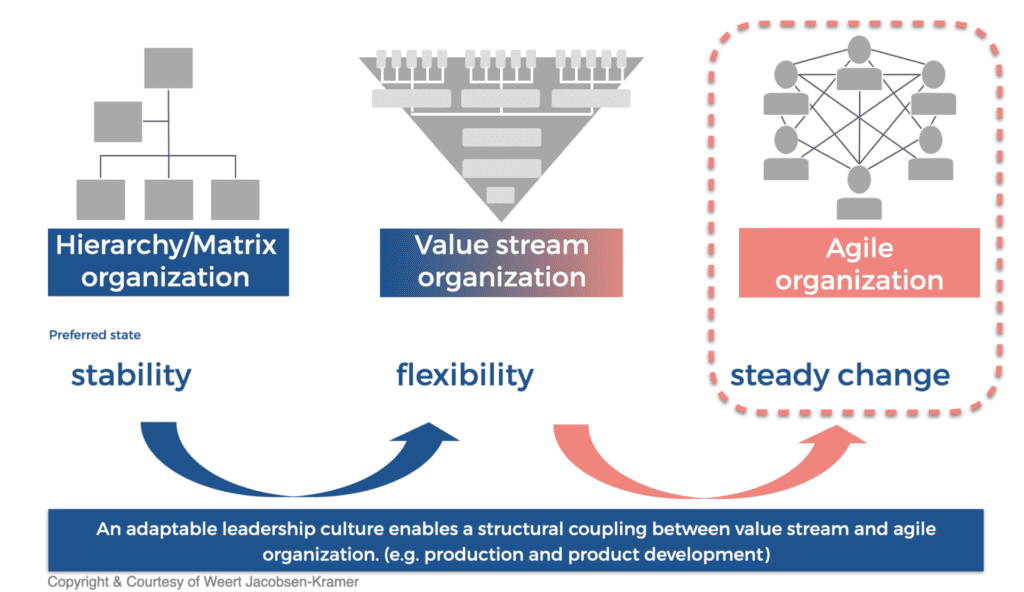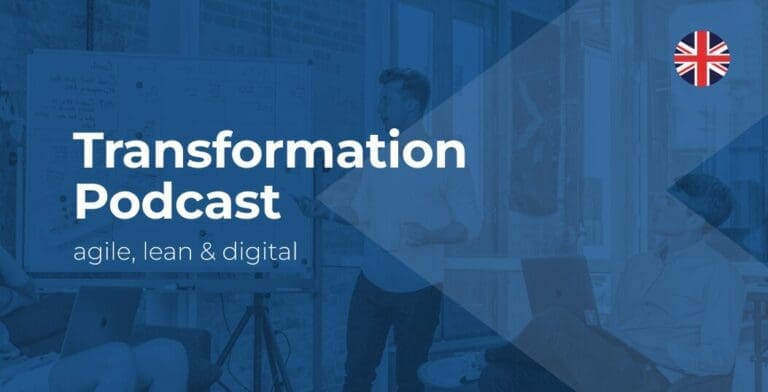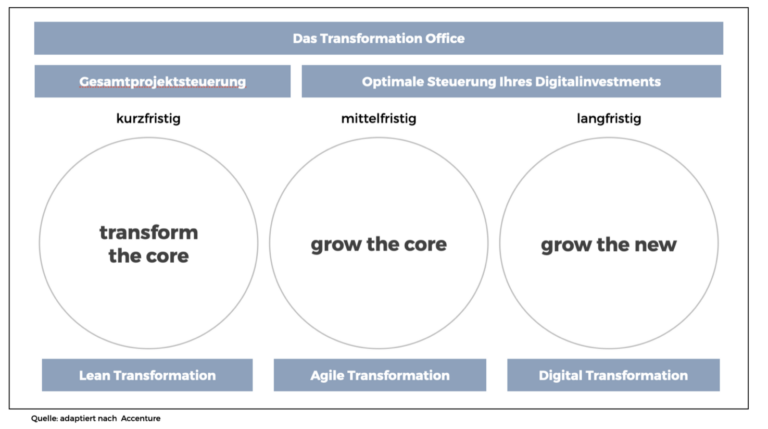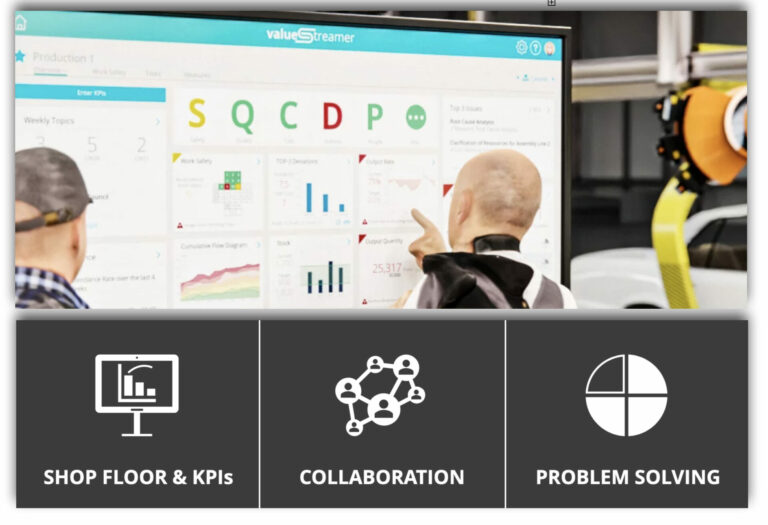Corporate Culture is the new key differentiator!
Increase your change ability – a new perspective on the agile organisation
Change ability requires the curiosity to learn and exchange ideas with the openness to think beyond the ordinary. It requires to be ready to throw old principles over board and welcoming new and seemingly radical concepts.
Your world-view: moving away from command-and-control
The concept of the agile organisation offers businesses a whole world of new ideas. As an expert on organisational development, Weert Jacobsen-Kramer, will introduce the paradigm of agile organisations to you. He will lay out the main differences towards traditional organisations along four criteria: world-view, mind-set, management tools, organisational model.
Command and control world view
Our world-view determines our organisational model. Leaders in traditional organisations are lead by the idea that “change can be managed”. They believe “we train staff” to fit their job requirements. This idea may be true in certain circumstances. However it carries a linear “machine like” world view, which is determined by a command-and-control paradigm. In this world we run “change projects”, plan “optimisation programs”, roll-out “Leadership Trainings” and decide on “cost reduction initiatives”. Does this sound familiar to you? If so you may want to find out more about a totally different world.

Contact us now!
We have more than 20 years of experience and deliver high quality consulting for your Agile, Lean or Digital Transformation.
Agile world view
The world-view in the agile organisation is inspired by nature, by natural systems and the idea of non-linear causality. This view offers new insights and innovative solutions for daily leadership challenges. An organisation is seen as natural, living and complex social system. The individuals act autonomously based on recurrent feedback loops vis-a-vis their environment and align themselves in a continuous process. Constant change is an integral part of this world in which self organised organisms drift together – structurally temporarily coupled – with other organisms through the environment. Change “simply happens” and can not be managed as such.
Speed of learning in the new key differentiator
Out of this non-linear perspective one is able create an organisational culture, that enables faster feedback loops, thus learning. This is essential because we are aware by now, that the speed of learning is the key differentiator and the competitive advantage in the digital world. The player that learns faster than other players is able to develop better solutions for customer demands in the market.
Managers and leaders in this non linear world know, that they can not plan and control this development process as such. They know they can however create the framework and the environment that enables faster learning and thus innovation.
Leadership mind-set: the traditional leadership role is changing
In the agile organisation the leadership role changes from that of a leader in a traditional organisation. Key elements of the traditional leadership role are now managed by self organised teams in organisations in which practically anyone takes leadership.
New mind-set
This new leadership roles is based on a new and fundamentally different mind-set. Employees are basically trusted and are regarded as autonomous, self-motivated individuals, which do not need to be motivated nor changed. In a joint collaboration effort, employees develop meaningful positive goal pictures of their team future, which makes sense to each and every one. Team members focus on their job roles and on their personal strengths, develop themselves and learn to realize their full potential.
The key leadership mind-set in the agile organisation is shaped around the idea that members in the organisation realise that each and everyone knows something different. Thus the goal is to bring those observations points and perspectives together to create something unique for the good of a larger whole.
Continuous prototyping
The learning culture is formed by the idea that a culture of conducting continuous experiments will lead to early prototypes and eventually new products that serve the customer better than ever before. The possibility of failure is seen as a matter of course and mistakes are seen as a chance for improvement. By the way new evidence from neuroscience shows that the following conditions especially foster deep learning experiences: appreciation, trust, a meaningful task, the possibility to contribute, facing challenges, receiving direct feedback and dealing positively with mistakes.
Agile organisations are focused on creating this culture of collaboration. In doing so they establish astounding new management tools.
Management tools: abandoning traditional tools – embracing new practices

Agile Organisations develop new and very effective management tools. For their project management they will often use SCRUM of KANBAN – project management methodologies that are by now well established and well known in the business world. However we will also find interesting management tools in other management areas, that are less known to the general public.
The agile organisation allows its employees to practically take any decision. A well structured decision making process manages how employees can exercise the right and duty´s of this complete freedom to take any decision.
Also you will find a fundamentally different practice when it comes to developing goals in the agile organisation. In contrast to traditional companies in which goals are set top-down through a goal setting process, in the agile organisation employees set their own goals as their contribution to company´s vision and mission. The key question here is: “What is your contribution to our organisation in the next 6 months?”
Organisational model: shared power
The agile organisation does without traditional leadership hierarchy, because everyone can take leadership on basically anything. Thus the traditional “Family tree” organisation chart structure becomes obsolete. The agile organisation instead corresponds to a network structure in which power is shared between the players. The agile organisation is organised in circles in which the team members act on the power and responsibilities given to them according to their roles – instead of acting on a certain power due to their management position.
Evolution of Organizations

The base for this new type of collaboration is formed by an organisational constitution. The articles of this constitution manages the collaboration between the circles and the different roles inside the circles. It describes the communication and decision making process and the different types of meetings that are conducted to align within the and between the circles towards the vision and mission of the organisation.
That does sound familiar to a traditional organisation, right? However the essential difference is that there is no manager or leader that an employees needs to contact to ask permission to act. Everyone is in principle free to act on what he or she thinks is best for the company.
In the agile organisation change is a constant and natural automatic process. The employees investigate into new market trends, “sensing” customer needs, collaborating together to find new creative and unique answers. The single organisation circle has the freedom to conduct new learning experiments, that are then shared with and may contribute to the development of the whole organisation.
Lean management and agile management: how does that fit together?
Now if you have engaged in lean management practice in the past, you may find yourself asking now: “How does lean management fit into the agile world and vice versa?”
In every organisation or business – agile or not – you have a value stream, in which the value is created that the customer is willing to pay for. Lean management is an excellent paradigm and provides very useful management tools to do exactly that: increase value in the value stream. This is especially true for production companies that have value chains across organisational business units.
Consequently lean management is really the fundamental prerequisite to become an agile organisation. Because an organisation – agile or not- that does not control its value stream has no reason for being in the market.
Having said that, it is possible to have parallel worlds in one company, with e.g. a lean management approach in production and an agile approach in product development.
Corporate Culture: the new key differentiator!
To be able to manage these two worlds in one company or to fully transit from the traditional leadership model towards the agil approach you will need a corporate culture capable of bearing these differences or this shift.
Therefore developing a self supporting, sound and sustainable leadership culture in your organisation is the key to realise a complete lean transformation on one side and to shift towards an agile organisation on the other side.
Weert Jacobsen-Kramer, December 7th, 2017






